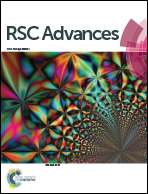Three pillared-layered inorganic–organic hybrid polymers with efficient luminescence†
Abstract
Three pillared-layered inorganic–organic hybrid polymers, namely, [Cu2(4,4′-Hbpt)(SCN)2]n (1), [Cd(4,4′-Hbpt)(SCN)2]n (2), and [Cd(4,4′-Hbpt)(SCN)2·CH3CN]n (3) were synthesized via layer diffusion methods. In all three complexes, there exist 2-D neutral wave-like d10 metal thiocyanate layers (for 1, [Cu2(SCN)2]n, and for 2 and 3, [Cd(SCN)2]n) with (4, 4) topology, which are further connected by bidentate 4,4′-Hbpt ligands to form 3-D structures with the primitive cubic topology. The results of photoluminescence and thermogravimetric analyses indicate that the three complexes are good candidates as luminescent materials. This paper provides a strategy to synthesize a novel family of pillared-layered inorganic–organic hybrid polymers constructed with layered d10 metal thiocyanate layers and conjugated organic spacers at the molecular engineering level, as well as the discovery of new patterns of crystallization at the crystal engineering level.



 Please wait while we load your content...
Please wait while we load your content...